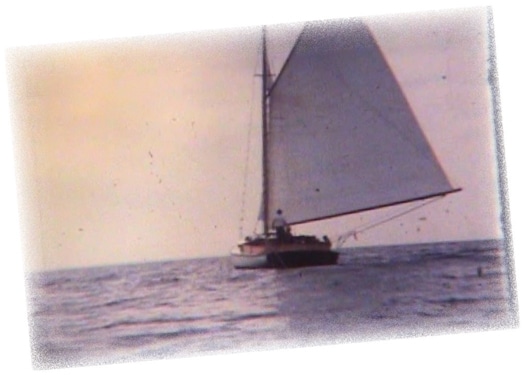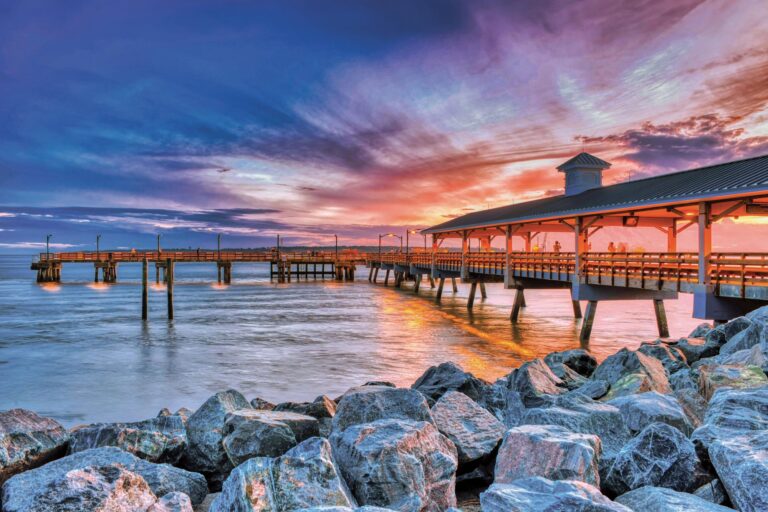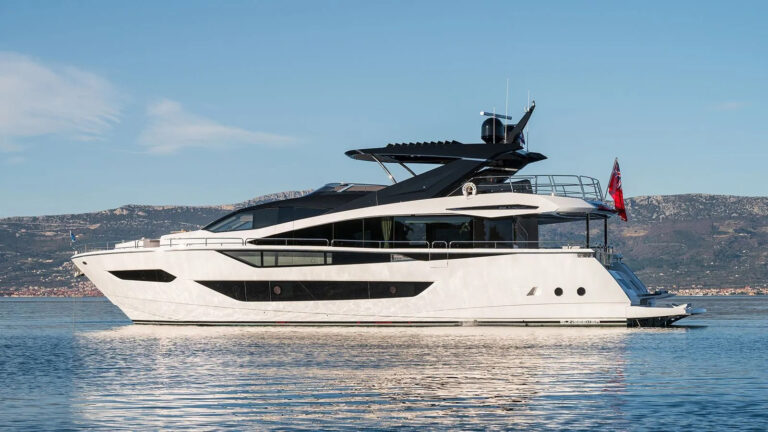
ytgoct23short525.jpg
“Mayday, mayday, mayday… this is the sailing vessel Westmoreland, over.” Time after time I repeated the Mayday call, the words flowing mechanically from my mouth into the microphone of the old Raymarine AM ship-to-shore radio. The bilge water had risen over the cabin sole and now sloshed halfway to my knees. I had no way of knowing whether the distress call was transmitting, but there had so far been no reply through the static and noise.
At 40 ½ feet long, with a 14-foot beam, Westmoreland was one of the largest catboats Crosby, of Osterville, Massachusetts, had ever built, and she featured the characteristic plumb stem, pumpkinseedlike wide beam, shallow draft, tree-trunk solid wooden mast, and enormous gaff-rigged mainsail. The solid varnished main boom, extending a good six feet aft of her transom, combined with the huge bright-finished gaff, provided Westmoreland with a mainsail area of nearly 1,000 square feet. Also, a previous owner had fi tted her with a five-foot bowsprit and head stay for carrying a small jib. Her wideopen aft cockpit was ideal for leisure sailing and entertaining, with plenty of seating around each side of the aft-facing worm-gear helm. A listing by John Alden brokerage in 1922 remarked that the “cockpit holds 35 men.”
When she was built in 1919 as an auxiliary keel fishing sloop, she was a strong, capable vessel for her purpose. In the nearly 50 years that followed, she sailed around New England, and spent many of her later years in the sheltered, shallow waters of the Great South Bay on the south shore of Long Island.
Fresh out of college, seeking adventure (and employment) with a couple of friends, I fell in with Westmoreland’s new owner, Paul, a globe-trotting celebrity hair-stylist. He enticed us with promises of sailing in the West Indies while entertaining his Hollywood clients (glamorous ladies). We were in New York in November. It was cold and dreary. There were few immediate job prospects. This sounded great!
One of my mates had studied at Fort Schuyler Maritime Academy, had a sextant, and supposedly knew navigation. (The fact that he was on probation for sailing a boat to Morocco without the boat owner’s “permission,” had spent time in a Casablanca prison, and was not legally supposed to leave New York State, was all information that I gleaned much later in our journey.) My other mate had been around boats his entire life and worked as a mate on fishing boats for years. Another freezing winter baiting hooks and fishing for cod was not at the top of his list of things he looked forward to.
While I had grown up in a commercial fishing family, had done a bit of small-boat sailing, and knew basic navigation, I had never been offshore except coastwise in my Dad’s fishing boats. But we were in our early 20s, enthusiastic, fearless, and ready to go.
The original plan was to sail the Intracoastal Waterway down to Florida, then work our way through the Bahamas, down the “thorny path” to the Virgin Islands. We pushed off at dawn, motoring and sailing to cover as many miles as possible before darkness forced us to anchor for the night. Everything was going reasonably well. As anyone who has ever made this trip in a small, slow boat knows, it gets dark early in the winter months, there are delays at bridges, it takes time to get un-aground. At the end of the day, when you check your progress and see how far you have to go, you grow dangerously impatient.
So, when our “experienced offshore navigator” traced a line straight offshore from Charleston directly to Puerto Rico, and suggested that we quit the ICW, we began to tally up all the miles and days we could save by taking the direct route. We would be partying in the Virgin Islands before Christmas! What could go wrong?
The first day, heading offshore, went smoothly enough, with light breezes and a slight swell. By evening the breeze began to build from the northeast and seas buffeted the boat, making conditions uncomfortable. All of the gear, which had been stowed in place in the calm conditions of the past, began to fly about the cabin and get underfoot. Locker doors flew open, dumping cans, bottles, and boxes everywhere. Water squirted in through leaky ports and around the skylight. With the gaff swinging wildly from side to side, we at first tried to reef the huge mainsail-eventually, we decided to leave the mainsail down and secured and just fl y the small working jib.

| | |
Conditions rapidly deteriorated… Without an anemometer, we could not know how hard it was blowing. The wind shrieking through the lazy jacks and shrouds told of gusts in the 40s, if not 50s, whipping directly against the Gulf Stream. Enormous seas built up and crashed over the boat. Bilge water had sloshed under the cabin sole and shot up through the fl oorboard joints. Soon the water was ankledeep as the boat rolled. We changed course back towards Charleston and away from the Gulf Stream. Despite trying to keep the boat on a heading that provided the least violent angle to the seas, it felt that we often rode up the crest of a huge roller and then were suddenly dropped, with Westmoreland’s wide, almost flat bottom slamming down in the trough. We worked to keep the two electric bilge pumps going. A wooden boat of this age has accumulated a lot of debris in her bilges. The wood shavings and chips of a hundred repairs and projects, the rags lost beneath the engine, bits of plastic and wine bottle corks-all hidden from view behind fl oor frames, cabin sole supports and a hundred other nooks and crannies-were flushed out of their long-held hiding places by hundreds of gallons of sloshing seawater. The pumps would only suck out water for a few moments until they had to be shut down and manually cleared of debris and we were not making any headway against the rising bilge water.
In between clearing pumps and calling “Mayday,” we began to use large pots from the galley to scoop up water from the cabin and dump it out the companionway into the cockpit. I called to Gene, an enormously built Cherokee friend of the owner’s who was seriously seasick, lying on a bunk just above the rising water, “Gene! Get up! Help us bail!” He moaned “I feel like I’m gonna die!” I yelled back “We’re all gonna die if you don’t help bail!” He did not move.
We kept the engine running, motorsailing with the jib for best steering control and to keep the batteries charged for the pumps. I could not find a source for the leak, which seemed to be gaining on us. The seacocks for the engine, head, and galley plumbing appeared to be sound. The tremendous pounding we took each time the boat fell off a wave and came crashing down was just too much for this old boat’s fastenings and caulking.
“Mayday, Mayday, Mayday. This is the sailing vessel Westmoreland, over…” we tried again and again, with still no reply. The radio was a crystal- controlled double-sideband set, the size of a microwave oven, the kind used before the VHF and single-sideband radios of today. The speaker popped and crackled with noise and static. When I keyed the mic, I had to wait for the motor-driven transmitter to get up to speed before speaking. Although we seemed very alone out there, I knew that a signal could bounce and skip a considerable distance, depending upon atmospheric conditions.
It was just such a skip that allowed a sportfishing boat, motoring along the Intracoastal Waterway in North Carolina, to hear our distress call from over 150 miles away. We were thrilled to hear a reply! While I couldn’t make out the name of the boat, I was able to give them our basic information: We were a sailboat, 130 miles east of Charleston, and taking on water. They in turn relayed this information to the U.S. Coast Guard before they faded out. The radio skip that had allowed us to briefly pass our information was now gone. While our situation hadn’t changed, we hoped that someone knew our plight.
Periodically, I repeated the Mayday calls, with no further reply. Finally, I received a loud, relatively clear call back, “Westmoreland, this is United States Coast Guard C-130, over.”
Immediately, I replied, “Coast Guard C-130, this is Westmoreland, over!!”
“Westmoreland, United States Coast Guard C-130, please give me long count so I can triangulate on your position, over.” “Coast Guard, this is Westmoreland…long count…10…9…8…7…6…5…4…3…2…1…over.”
We gave long counts several times as their radio signal became stronger and clearer. The Coast Guard asked for a description of the vessel, how many people were aboard, hailing port, etc. We then deployed orange smoke and red signal fl ares from the leeward side of the cockpit.
One of the sweetest sights I have ever seen was that white and orange U.S. Coast Guard HC-130 breaking through the clouds and sweeping in towards us. When they zoomed by us with a wiggle of their wings, a shiver of joy and relief swept through my fatigue. The flashing lights and drone of the plane’s engines were comforting as they circled, radioing to say they would stay with us, and that a helicopter was en route.

| | |
We continued to bail and clear the pumps, trying to keep the rising water in check. Hungry and tired, we could only grab handfuls of soggy cereal to keep our energy up. Although we were unaware of it at the time, we had been battling storm and sea for over 36 hours. Finally, a loud, clear call on the radio identified itself as a Coast Guard helicopter and instructed us to get ready to receive a pump…thank God!
The helicopter crew indicated that they would first drop a sandbag-weighted line into the sea to dissipate any static electric charge. They would then drag this line over for us to use as a tag line to retrieve the pump. The orange sandbag soon became hopelessly snarled in our lazy jacks. Trying to free this line from the top of the bouncing, rolling cabin was inviting disaster. So, we cut the sandbag free, then hauled the lowered pump container through the waves, banging it up over the rail into the cockpit. The pump was inside a cut-off 55-gallon drum with a ring band sealing the cover. We soon had it open, uncoiled the heavy three-inch suction line, and ran the strainer-protected end through the companionway into the rising bilge water. We set the pump in the cockpit and hooked up the suction line and fire hose discharge. After checking for gas in the tank (it was full), I pumped the primer bulb, set the choke, and pulled the starting cord. Nothing. Reread the instructions, and tried again and again. Still nothing. I know a bit about these small engines and can usually get cranky ones started, but this engine would not go. We let the helicopter crew know and they said they would send down another pump.
Though the second pump came down with fewer problems than the first, it was still a 40-minute ordeal. But once we had it set up, it came to life on the second pull. However, try as we might, we could not get that sucker to suck! I was priming and venting and doing whatever I could. The helicopter, still standing by, advised us that they had one more pump, if we wanted to give it a try. They were running low on fuel and had to head back to the mainland.
The first two pumps looked brand new, packed in beautifully painted containers. The third pump, which we once again struggled to wrestle aboard, was in a rusty, beat-up container, and the pump itself looked like it had seen better days. But it fired up on the first pull and started pumping like a fire hydrant. Cheers all around! We profusely thanked the helicopter crew as they disappeared to the west.
With The HC-130 Still Circling, we slowly made our way towards Charleston. The constant spray and waves that were still crashing over us quickly shorted out the ignition on the pump engine. After drying the sparkplug and ignition wire and spraying them with WD-40, I pulled a canvas tarp over my shoulders and formed a shelter around the pump. Even in the strong wind, the engine exhaust fumes under the canvas were nasty, and I had to duck my head out frequently for fresh air.
That crusty old pump worked well, though, and after it had run for about an hour, the water level was so low that the suction line was sucking air. Though I feared doing so, I shut the pump down. We then monitored the rising water and cycled the pump on and off as needed.
The radio again crackled to life with a call from the 210-foot U.S. Coast Guard Reliance Class Cutter Diligence that was now approaching us. They said that they wanted to pull up parallel to us, close enough to shoot across a line with a VHF radio. It was after dark when the Diligence came into view and positioned itself about 100 yards off our starboard side. The seas at this point were still large enough so that one moment we could see the Coast Guard cutter, then it would disappear entirely in the trough of the next wave. Even their masthead light would disappear! The Coast Guard estimated the seas at 40 feet. Forty feet? If they were 40 feet now, what were they 18 hours ago when it was really blowing? We learned later that about 20 miles away from us, in the same storm, an 800-foot tanker had broken in half!
As a brave Coast Guardsman fought his way to the bow of the pitching and rolling cutter, we were cautioned to stand clear. We heard a bang as the line sailed through the spray and landed ahead of us in the sea. After retrieving this missed line, they fired another. We grabbed the line as it fouled in our rig up forward. Hand-over-hand, we pulled the line in through the waves. The coasties had attached a heavy canvas and plastic-wrapped bag with a VHF FM transceiver under layers of waterproofing. Finally, we had clear, static-free communication with the Coast Guard.
While conditions were still rough, with the gasoline-powered pump keeping us afl oat, our diesel engine still running, and the crew mostly seasick, but otherwise okay, the most prudent course of action was for us to continue towards Charleston under our own power. It would have been difficult and dangerous for the Coast Guard to try to take us under tow. So they escorted us all night, as we slowly made our way to the west. Eventually, the winds and seas abated and conditions aboard became more comfortable. We kept our routine of firing up the pump to clear the bilges of water, and then shutting it down again, until the next cycle. With Westmoreland under less strain, the pumping cycles were extended.
When we were-at last!-only a few miles from the Charleston sea buoy, the big Coast Guard cutter swung back out to sea, passing its escort duties to a 41-foot U.S.C.G. patrol boat. As with the noble coasties who first located us from the C-130, and the superbly skilled, patient guys in the chopper who gave us the lifesaving pumps, the professionals in the big cutter Diligence were heading back to their duties at sea without giving us the chance to tell them how grateful we were to them for saving our lives.
These old cat boats were never meant to go offshore. I’m sure a lot of old timers could have told me that before we left New York but I had to learn it the hard way. We motored Westmoreland down the ICW, all the way to Spencer’s boatyard in West Palm Beach, where I left her for a new berth in a staunch 77-foot Rhodes steel ketch, bound for the islands at last. And that was the beginning of another series of adventures…
Ron Schaper holds a 100-ton masters license, has sailed professionally for many years, and is active in racing.








